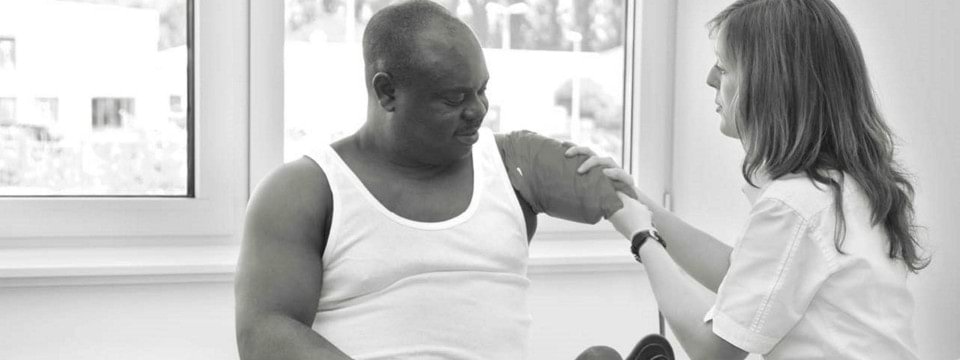After the amputation
Immediately after your operation, the focus will be on your recovery and the healing of your arm, also referred to as your residual limb. A healthy recovery is important so that you can start rehabilitation soon and be fitted with a prosthesis.
Your treatment team will decide when you can start with intensive rehabilitation based on how your recovery is going. During your rehabilitation process, you will be fitted with a prosthesis tailored to your specific needs, and supported by a rehabilitation team that could include physicians, physical therapists and occupational therapists, a prosthetist and nursing staff. These professionals are there to support you and to ensure that you are well prepared. During rehabilitation you will learn how to properly care for your residual limb, as well as the rest of your body.
Before you can wear a prosthesis, your residual limb must be healed and have attained the proper shape. This means that all fluids that accumulated due to the operation have been removed through compression therapy and that the residual limb swelling (edema) has subsided.
After the amputation

What to expect after an amputation surgery
When you wake up from the anesthesia, your arm will have likely been treated with simple bandages with a small drainage tube leading out of it. This tube was laid into the wound during the operation so that wound seepage and blood can flow out of the wound, and will be removed from the wound during the healing process.
In most cases the amputation wound closes and forms a scar within the first three to four weeks. But even if the scar looks like it has healed well from the outside and only the color of the scar tissue is changing slightly, complete healing of the scar may take significantly longer.
During this period compression therapy and skin care creams are enormously important in helping the scar tissue remain soft and pliable—while simultaneously making it stable enough to wear a prosthesis.
Compression therapy

Correct Positioning
Even during your initial recovery in the hospital bed, it’s important that you maintain the correct body posture so that your muscles and joints do not shorten or stiffen – which could prevent full use of your joints. While most patients initially assume a comfortable, pain-free position, experience has shown this is not always ideal.
In fact, the residual limb should be extended as much as possible—and under no circumstances should it be elevated for an extended period of time (such as on a cushion) because the muscles may shorten and residual limb mobility may be reduced.

Compression Therapy
With the aid of pressure applied to the residual limb over a large surface area, swelling (edema) of the residual limb can be reduced and the residual limb can be formed for the future prosthetic fitting. This compression of the residual limb contributes to being able to do your prosthetic fitting as soon as possible and to making it easier to adjust your prosthesis. In addition, compression aids circulation in the residual limb. This reduces the amount of pain and results in improved healing of the scar.

Silicone Liners
Silicone liners offer a further method for achieving compression. Silicone liners are available in standard sizes as well as customized fabrications. The liner exerts even pressure on your residual limb and forms it properly. In addition, the flexible, skin-friendly silicone can help make the scar soft and pliable.
To put the liner on, it is best to first turn it inside out and then roll it evenly onto your residual limb. Don’t pull it up like a sock, and take special care to ensure that no folds or air pockets form.
Clean your liner daily with a skin-friendly, unscented soap and warm water. If you sweat a lot, you should clean it several times a day and possibly use a disinfectant. Have your prosthetist explain the care of your liner in detail and follow directions in your user’s manual.Caring for your skin
Skin- and scar care

Caring for your skin
Your therapist will show you how to properly care for your residual limb. In order to prevent the skin from becoming rough and scaly, wash the residual limb with warm water and a mild soap (such as Derma Clean) every morning and evening. Then dry the skin thoroughly or carefully dab it dry and put cream on it. Derma Repair and Derma Prevent, two products from Ottobock, were developed specifically to care for highly stressed skin such as that on a residual limb. The Derma Prevent cream, for example, guards against chafing by covering the skin like a protective film keeping it soft and pliable.
If folds of skin or retracted scars, also known as invaginations, have formed on the residual limb, they must receive particularly intensive care in order to prevent infections. Have your rehabilitation team advise you in this regard. In addition, look out for injuries, pressure sores, and blisters while you care for your residual limb. These must receive medical treatment. A mirror can help you look at the back of your residual limb. Regular massaging and careful stretching of the scar is another important component of residual limb care.
Also note that putting the prosthesis on in the morning right after you wash is often more difficult than usual, since warm water causes the skin on the residual limb to swell.

Desensitising the skin
The skin on the residual limb is often very sensitive following the surgery. There are ways to reduce these sensations: Take a soft brush or porcupine massage ball and use it to brush or tap the sensitive area. This decreases sensitivity. You can also rub down the residual limb with a rough towel or washcloth.
Only use materials that you are comfortable with, and work from the end of the residual limb towards the body.
Residual limb hygiene is also very important fol¬lowing wound healing. The residual limb must be washed daily using water and unscented skin-friendly soap. Ottobock care products can make residual limb care and cleaning easier.

Scar Treatment
In most cases, the surgical wound closes within the first three to four weeks and a scar is formed. Even if the scar appears to have healed well from the outside and the appearance of the scar tissue appears to remain constant, the overall scar heal¬ing process can take much longer. It can take up to 18 months for the wound to heal completely underneath the skin.
You should moisturise your scar regularly from soon after the surgery as scar tissue lacks the ability to produce its own oils. Unscented creams are highly recommended. Such intensive care is important in order to ensure that the scar tissue remains soft and elastic while simultaneously becoming resilient. This is required so that you will be able to wear the prosthesis, since proper care prevents residual limb pain from developing in the prosthetic socket during movement.
Early compression therapy is also important to affect scar formation. Full-coverage compression combined with a silicone interface is the best way to prevent the development of excessive scar tissue.
Training without prothesis

Preparatory therapy exercises following surgery
In order for your body to be well prepared for the next treatment steps and so that you remain mobile, exercises to stretch and strengthen the trunk, arm, and leg muscles are highly recommended. Have your physical therapist show you exercises which support your recovery and also train the joints near the amputation location as much as possible.

Improving the Dexterity of the Sound Side
Training of the sound side follows, depending on whether your dominant hand or the opposite hand was affected. Fine motor skills, dexterity and strength training will be practiced. The more capable you are with your sound hand, the better you’ll be able to perform Activities of Daily Living and take care of yourself. It’s important to practice challenging activities such as writing or brushing your teeth.

Stretching the Residual Limb Musculature
The muscles and joints around your residual limb – for example the shoulder joint – need stretching. If you have trouble moving these joints actively, it is possible to use a towel to passively stretch them. It’s important that you maintain or regain maximum joint mobility.

Muscle Strengthening of the Torso
Because the loss of a limb also causes the loss of weight on the amputated side - which can lead to imbalance and poor posture - it’s important to pay special attention to keeping your torso in balance and maintaining a healthy back. Back exercises can aid in this maintenance. Special attention to these things before the prosthetic fitting can prevent the development of any malpositions and make it easier to transition to using your prosthesis.
Once you start wearing the prosthesis, its weight compensates for the loss of mass. If malpositions have already developed, special exercises can be used to correct this or prevent further progression. A stable and balanced torso will make it easier to control your prosthesis.
Rehabilitation

Once your residual limb has been properly formed you’ll learn more about your prosthesis. You’ll be instructed in how to take care of it as well as your residual limb, and you’ll also begin training with it.more



